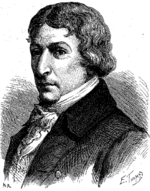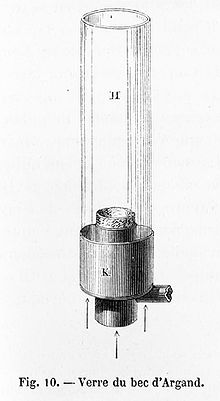206:
167:
31:
225:
During this period, in 1780, he started to invent improvements on the conventional oil lamp. The basic idea was to have a cylindrical wick which air could flow through and around, increasing the intensity of the light produced. A cylindrical chimney enhanced the air flow and a series of experiments
272:
The demand for the lamps was high, and the partners had many difficulties at first in manufacturing them, but they eventually became the standard source of illumination in homes and shops. Many imitators and improvers evolved new variations, and thousands of shops sprang up to produce them in the
240:
Many problems attended the successful development of a lamp that could be a commercial success. Argand experimented with all of them, searching for practical compromises. The design manufacture of the wick was solved by a lacemaker. The type of glass to use next to the hot flame was a problem
197:. He published several scientific papers on meteorological subjects while in Paris in his late twenties. He took a teaching post in chemistry and developed some ideas for improving the distillation of wine into brandy, and, with his brother, successfully built a large distillery.
245:
was eventually settled on, which eventually created an important new industry. The mechanism for holding the wick and moving it up and down went through many variations. Even the solder used to fabricate the oil reservoir was a problem when it was discovered that the soft
226:
gave the proportions for optimum operation. A mechanism for raising and lowering the wick allowed some adjustment and optimization as well. The light was much brighter than a candle (by a factor of five to ten), burned cleanly, and was cheaper than using candles.
237:. When he was there, his acquaintance Antoine-Aroult Quinquet, to whom he had shown an early prototype, began to manufacture the lamps himself, with minor change, and successfully fought a protracted legal battle for patent infringement.
193:, the ninth of ten children. His father was a watchmaker, who intended for him to enter the clergy. However, he had an aptitude more for science, and became a pupil of the noted botanist and meteorologist
250:
joints leaked. The invention of the lamp did not consist, then, of only one invention, but rather of the improvement and development of a complete system of parts all working together, not unlike
420:
205:
328:
241:
eventually solved. All available types of oil to use were tested, and methods to purify them for use were the subject of a number of experiments.
440:
455:
450:
316:
257:
In
October of the same year, he determined to manufacture his lamp, in England. He eventually formed a partnership with
406:
349:
233:
Jacques-Étienne and Joseph-Michel in France and became closely involved with his sensational experiments to devise a
214:
140:
265:
to manufacture the lamp. In 1784, he received a patent for his design. Argand also formed a close relationship with
194:
401:
445:
254:'s invention of the electrical lighting system that was to again revolutionize lighting over a century later.
55:
258:
269:
who performed some experiments on the lamp's efficiency and advised him on waging his court battles.
81:
435:
430:
425:
230:
8:
190:
345:
262:
234:
312:
218:
414:
274:
251:
179:
331:, Biographie universelle ancienne et moderne, vol. 56, Paris, Michaud 1834.
166:
171:
151:
266:
210:
280:
The invention of the lamp was not, in the end, profitable for Argand.
242:
143:
112:
155:
92:
289:
147:
117:
293:
247:
186:
77:
51:
30:
292:
and suffered from it for twenty years before dying in
342:
Brandy, Balloons, & Lamps: Ami Argand, 1750-1803
273:
next decades. They were eventually displaced by the
421:
18th-century physicists from the
Republic of Geneva
412:
139:(5 July 1750 – 14 or 24 October 1803) was a
344:(Southern Illinois University Press, 1999).
161:
185:Francois-Pierre-Amédée Argand was born in
154:, a great improvement on the traditional
204:
165:
413:
317:Historical Dictionary of Switzerland
283:
209:Argand demonstrating his balloon to
441:People of the Industrial Revolution
13:
14:
467:
394:
29:
381:
372:
363:
354:
334:
322:
306:
1:
299:
133:François-Pierre-Amédée Argand
23:François-Pierre-Amédée Argand
16:Genevan physicist and chemist
176:Les meirvelles de la science
7:
456:19th-century industrialists
451:18th-century industrialists
195:Horace-Bénédict de Saussure
10:
472:
200:
126:
105:
98:
88:
62:
37:
28:
21:
162:Early life and education
178:, published in 1867 by
222:
182:
446:18th-century chemists
208:
169:
66:14 or 24 October 1803
231:Montgolfier brothers
229:In 1783, Argand met
170:Illustration of the
221:on 26 November 1783
174:, which appears in
223:
191:Republic of Geneva
183:
150:. He invented the
56:Republic of Geneva
284:Illness and death
130:
129:
100:Scientific career
463:
405:In light houses
388:
385:
379:
376:
370:
367:
361:
358:
352:
338:
332:
326:
320:
310:
73:
71:
48:
46:
33:
19:
18:
471:
470:
466:
465:
464:
462:
461:
460:
411:
410:
397:
392:
391:
386:
382:
377:
373:
368:
364:
359:
355:
340:Wolfe, John J.
339:
335:
327:
323:
311:
307:
302:
286:
277:in about 1850.
263:Matthew Boulton
235:hot air balloon
215:Queen Charlotte
203:
164:
122:
84:
75:
69:
67:
58:
49:
44:
42:
24:
17:
12:
11:
5:
469:
459:
458:
453:
448:
443:
438:
433:
428:
423:
409:
408:
403:
396:
395:External links
393:
390:
389:
380:
371:
362:
353:
333:
321:
304:
303:
301:
298:
288:He contracted
285:
282:
259:William Parker
219:Windsor Castle
202:
199:
163:
160:
128:
127:
124:
123:
121:
120:
115:
109:
107:
103:
102:
96:
95:
90:
89:Known for
86:
85:
76:
74:(aged 53)
64:
60:
59:
50:
39:
35:
34:
26:
25:
22:
15:
9:
6:
4:
3:
2:
468:
457:
454:
452:
449:
447:
444:
442:
439:
437:
434:
432:
429:
427:
424:
422:
419:
418:
416:
407:
404:
402:
399:
398:
384:
375:
366:
357:
351:
350:0-8093-2278-1
347:
343:
337:
330:
325:
318:
314:
309:
305:
297:
295:
291:
281:
278:
276:
275:kerosene lamp
270:
268:
264:
260:
255:
253:
249:
244:
238:
236:
232:
227:
220:
216:
212:
207:
198:
196:
192:
188:
181:
180:Louis Figuier
177:
173:
168:
159:
157:
153:
149:
145:
142:
138:
134:
125:
119:
116:
114:
111:
110:
108:
104:
101:
97:
94:
91:
87:
83:
79:
65:
61:
57:
53:
40:
36:
32:
27:
20:
383:
374:
365:
356:
341:
336:
324:
308:
287:
279:
271:
256:
239:
228:
224:
184:
175:
136:
132:
131:
99:
436:1803 deaths
431:1750 births
426:Protestants
387:Wolfe p 151
329:Aimé Argand
313:Argand, Ami
296:at age 53.
172:Argand lamp
152:Argand lamp
135:, known as
41:5 July 1750
415:Categories
378:Wolfe p 54
369:Wolfe p 29
300:References
267:James Watt
211:George III
137:Ami Argand
70:1803-10-25
45:1750-07-05
400:The lamp
360:Wolfe p 3
315:, in the
243:Whale oil
144:physicist
113:Chemistry
156:oil lamp
93:Oil lamp
290:malaria
148:chemist
141:Genevan
118:physics
68: (
43: (
348:
294:Geneva
252:Edison
248:solder
201:Career
187:Geneva
106:Fields
82:France
78:Geneva
52:Geneva
346:ISBN
261:and
213:and
146:and
63:Died
38:Born
217:at
417::
189:,
158:.
80:,
54:,
319:.
72:)
47:)
Text is available under the Creative Commons Attribution-ShareAlike License. Additional terms may apply.


